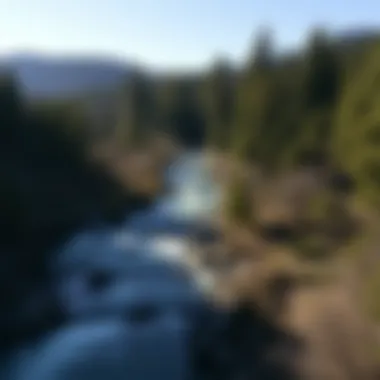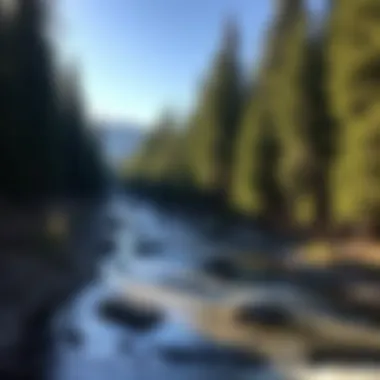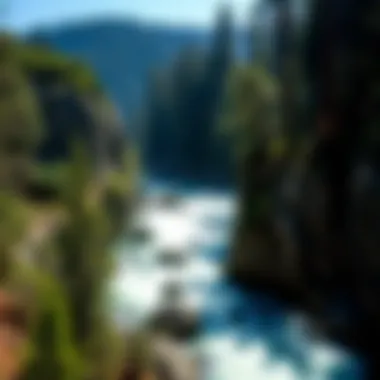The Yuba River: Ecological and Cultural Insights


Intro
The Yuba River is more than just a waterway weaving through the Sierra Nevada foothills; it’s a lifeline for diverse ecosystems and a cultural centerpiece for the people whose lives it touches. Originating from the melting snow of the Sierra peaks, the river's journey tells a story rich with ecological and historical significance. Its tributaries, meadows, and woodlands present a complex interplay that fosters a wealth of biodiversity.
Communities around the Yuba River have longstanding histories intertwined with the land, utilizing it for both resources and recreation. The river has shaped not just the environment but also the cultural practices, traditions, and economy of nearby populations.
In this exploration, we’ll delve into the forest ecology and biodiversity that make the Yuba River unique. From sustainable forestry practices that protect this precious resource to community engagement that ensures its preservation, our journey will be multifaceted.
Let’s embark on this insightful voyage to understand how the Yuba River supports diverse life forms and serves as a cultural beacon for the surrounding communities.
Preamble to the Yuba River
The Yuba River, coursing through the heart of the Sierra Nevada in California, is more than just a waterway; it's a pivotal entity that intertwines environmental dynamics with rich cultural narratives. Its significance stretches beyond mere surface beauty, echoing through the ecosystems it supports and the communities that cradle its banks. In understanding the Yuba, one must appreciate not only its physical attributes but also the stories embedded within its flow.
The introduction serves as a gateway into the delicate balance of ecological richness and cultural heritage that this river represents. With its meandering paths through diverse geographies, the Yuba River captivates anyone who lays eyes on it. By exploring its geographical settings alongside water characteristics, we can unravel the multifaceted role it plays in the region's ecology and society.
Through this exploration, readers will also find insights into how the river’s health impacts local biodiversity and how communities have historically and presently interacted with this natural resource. Understanding these aspects is crucial for both conservation efforts and cultural recognition. It’s an invitation to dive deeper into an ecosystem that supports life in myriad ways.
Geographical Overview
Nestled in Northern California, the Yuba River emerges from the Sierra Nevada mountain range, beginning its journey in the remote and rugged terrains of the Tahoe National Forest. Its upper reaches involve a network of streams, tributaries, and cascading waterfalls that contribute to its overall flow. The river meanders through Gold Country, a phrase that echoes the historic gold rush era, and eventually flows into the vast Feather River.
The river spans a significant distance, showcasing various landscapes along its path. From lush forests to rocky canyons, the Yuba flows through diverse ecosystems that support a rich tapestry of wildlife and plants. Each bend in the river brings forth unique geographical features, influencing the ecological make-up of the area.
The region is characterized by a Mediterranean climate, marked by wet winters and dry summers. This climatic pattern, coupled with the geological history of the area, plays a vital role in shaping the river's hydrological patterns.
Hydrology and Watershed Characteristics
The hydrology of the Yuba River is a complex interplay of rainfall, snowmelt, and geological formations. Spanning approximately 1,000 square miles, the Yuba River Watershed encompasses several tributaries, including the North Yuba and South Yuba rivers. This interconnected network is crucial for understanding how water flows and how watershed management impacts the surrounding areas.
The river's flow patterns demonstrate distinct seasonal variations. During spring, melting snow from the Sierra Nevada creates increased water levels, fueling the river's vigorous flow. This seasonal flooding contributes nutrients to the floodplain, which in turn supports a wealth of vegetation and wildlife. Conversely, during the summer months, the river’s flow diminishes, leading to warmer waters that can stress aquatic habitats.
A notable feature of the Yuba River's hydrograph is its susceptibility to human influence, particularly through irrigation practices and dam operations. These factors can lead to significant alterations in flow characteristics and habitat health. As forestry and land management practices evolve, understanding the hydrological dynamics of the Yuba River remains essential for the health of both its ecosystems and the communities that depend on it.
"The Yuba River is not just a waterway; it is a lifeline for cross sections of life, shaping landscapes and communities alike."
In summary, the introduction to the Yuba River sets the stage for a deep exploration into not just a river, but a flowing narrative of ecological significance and cultural context that beckons an audience eager to learn.
Ecological Importance
The Yuba River stands as a linchpin in understanding the health and well-being of its surrounding ecosystems. The river is more than just a body of water; it's a vibrant conduit of life, influencing local climates, supporting diverse species, and nurturing habitats that are crucial for both flora and fauna. The interplay of hydrology and ecological interactions is what makes this region so valuable—not just ecologically but also for the livelihoods of those who depend on these resources.
The ecological importance of the Yuba River can be broken down into various components, each contributing to the overall functionality of the ecosystems it supports. This includes its vast biodiversity, the various habitats that flourish along its banks, and the relationships between the flora and fauna that utilize these resources.
Biodiversity of the Yuba River
The river is home to a remarkable array of life forms, each playing a specific role in the ecological tapestry. The diversity of species found here includes fish like the steelhead trout, a prized catch for local anglers, as well as migratory birds that find sanctuary along the river’s riparian zones. Maintaining this biodiversity is paramount, as each species contributes to the river’s ecosystem health and stability. In a nutshell, the greater the variety, the better the ecosystem functions and the more resilient it becomes against environmental changes.
Habitats Supported by the River


Riparian Zones
Riparian zones, the verdant corridors along the riverbanks, are essential for the river's ecosystem. These areas serve as vital buffers, reducing erosion while filtering pollutants that might wash into the water. A key characteristic of riparian zones is their biodiversity, housing species from various ecological niches. This makes it a beneficial topic in our exploration, given their importance in offering shelter and food for numerous wildlife species. Furthermore, these zones often come equipped with distinctive features such as dense vegetation, which contributes to the moderation of temperature extremes and provides crucial shade for aquatic habitats.
Aquatic Ecosystems
Delving into aquatic ecosystems, they are the heart of the Yuba River’s ecological framework. Fish species, amphibians, and various invertebrates thrive within this environment, relying on clean, flowing water. The key characteristic of these ecosystems is their intricate food web, connecting the producers—like algae and aquatic plants—with predators, ensuring a balance in the ecosystem. A unique feature here includes the presence of diverse microhabitats such as submerged logs and rocky crevices, which offer shelter to various life forms. This complexity affords advantages as well, such as increased niche availability, but can also pose disadvantages if these habitats are compromised by pollution or development.
Terrestrial Habitats
Terrestrial habitats surrounding the Yuba River play a crucial role in sustaining local wildlife and maintaining ecological balance. These areas include meadows, forests, and grasslands that extend from the riverbanks into the uplands. The defining aspect of terrestrial habitats is their capacity to support a variety of species, including mammals, birds, and insects, which all rely on this land for nesting, foraging, and shelter. The unique feature of these habitats lies in their connectivity to the river, providing important resources while also serving as migration corridors for terrestrial wildlife. However, rapid development and human encroachment can significantly impact these habitats, leading to loss of biodiversity and ecological functions.
Flora and Fauna
The flora and fauna associated with the Yuba River exemplify the interdependence of species within the ecosystem. Native plants such as willows and cottonwoods are not just beautiful; they stabilize the banks and provide habitat. The fauna too, ranging from small mammals to apex predators, all interact within this rich landscape. Understanding these relationships highlights the fragile balance that maintains the Yuba’s ecological integrity and emphasizes the need for concerted conservation efforts.
Cultural Significance
The Yuba River is not just a ribbon of water flowing through the landscape; it holds profound cultural significance that resonates with both the history of the region and its contemporary communities. Such relevance stems from various intricate elements ranging from historical narratives, indigenous practices, to the vibrant traditions passed down through generations. Recognizing the cultural significance of the Yuba River helps in understanding how it shapes identities and community bonds.
Historical Context of the Yuba River
The history of the Yuba River is intertwined with the tales of gold rush and settlement. In the mid-19th century, it became a hotspot for prospectors seeking fortune. This fever brought forth rapid development, but it didn’t just shape economic landscapes; it sculpted social ones as well. The influx of outsiders altered the indigenous presence, impacting existing tribal structures and cultures. The remains of this rich past are etched in the local architecture and folklore.
Indigenous Peoples and the River
The indigenous peoples, including the Nisenan and Washoe tribes, have long viewed the Yuba as a sacred entity. For them, the river is a lifeblood, offering sustenance and spiritual connection. Traditional ecological knowledge tells a story of stewardship—of knowing when to fish or how to gather plants without depleting resources. This relationship transcends mere survival; it is about honoring ancestors while ensuring future generations can thrive in the same environment.
Cultural Practices Related to the Yuba River
Fishing Traditions
Fishing along the Yuba is much more than a past-time; it's a cornerstone of community identity and survival. Local tribes use time-honored techniques, such as spearing and basket weirs. These methods are not only effective but also carry significant cultural connotations, honoring ancestral practices. Fishing communities often see this method as a way of maintaining harmony between humans and nature. When fish populations dwindle due to various ecological pressures, it becomes an urgent call for dialogue about conservation and responsible practices.
Art and Storytelling
Storytelling, intertwined with artistic expressions, encapsulates the essence of the river's heritage. Artists draw inspiration from the lands and waters, creating pieces that reflect local tales—some portray the river as a nurturing mother, while others illustrate its fierce nature during floods. This creative expression preserves history and fosters community engagement, allowing visitors and locals to re-connect with the river’s cultural legacy. Stories based on the Yuba River often become vehicles for broader conversations about ecology and identity.
Festivals and Celebrations
Festivals celebrating the Yuba River are vibrant gatherings that embody community spirits. Events like the Yuba River Cleanup Festival not only honor the river's importance but also bring together diverse groups for environmental stewardship. Such celebrations create a space where people learn about local ecology and partake in activities like river rafting or nature walks, fostering a genuine connection with the landscape. Besides, these festivities are delightful touchpoints for families to bond, share histories, and appreciate what the river represents.
"The Yuba River binds us together, telling stories older than the rocks that cradle its flow."
Understanding the cultural significance of the Yuba River offers insights into its role beyond mere geography. It encompasses historical narratives, indigenous practices, and community celebrations, all of which contribute to a rich tapestry of meaning wielded by this majestic river.
Human Impact on the Yuba River
The human impact on the Yuba River serves as a critical lens through which we can understand the ongoing challenges and transformations faced by this vital waterway. The interplay between natural ecosystems and human activity illustrates a complex relationship that has evolved over time. Acknowledging these influences is essential, particularly for professionals in forestry and environmental sciences, as it highlights the necessity of responsible management and conservation strategies. This section provides an exploration of three main dimensions: historical development and land use, pollution and environmental challenges, and the impact of dams and water management practices.


Historical Development and Land Use
The history of the Yuba River is deeply intertwined with human settlement and development. Initially, the land around the river was primarily inhabited by Indigenous tribes, who utilized its resources sustainably. As time marched on, the California Gold Rush in the mid-1800s triggered a flood of miners and settlers drawn by the promise of wealth. This influx changed the landscape dramatically as mining operations often led to habitat degradation, deforestation, and soil erosion.
- Mining Techniques: Technologies used like hydraulic mining altered the river’s course and increased sedimentation.
- Agricultural Expansion: Following the rush, vast stretches of land were cleared for agriculture. This meant altering the natural ecosystems that had thrived there.
- Urban Development: Small towns evolved into larger communities. More roads, infrastructure, and housing had a lasting impact on the surrounding environment.
As a result, the original ecological balance has been disrupted, prompting a critical need for initiatives that mitigate these past impacts. The urgency to reconcile land use with ecological health remains a pressing concern today.
Pollution and Environmental Challenges
With development came pollution, a pervasive challenge confronting the Yuba River. Various forms of contamination—ranging from agricultural runoff to urban waste—pose significant threats to the water quality.
- Nutrient Loading: Fertilizers and pesticides from farmland can runoff into the river during rains, leading to harmful algal blooms.
- Heavy Metals: Historical mining operations have left a legacy of mercury contamination, affecting both wildlife and human populations.
- Plastic Waste: Increasing recreational activity, particularly during summer, has introduced litter into the waterway, exacerbating ecological stress.
These pollutants have cascading effects, from diminishing fish populations to affecting drinking water quality for nearby communities. Addressing these issues requires extensive collaboration among various stakeholders, including the government, local businesses, and community organizations.
Impact of Dams and Water Management
The Yuba River's flow has also been drastically altered by dam construction and water management practices. Dams like the Englebright Dam have significant implications for ecological and hydrological dynamics.
- Altered Flow Regimes: Dams modify the natural flow of the river, affecting sediment transport and the ecological health of downstream habitats. Some fish species, such as salmon, rely on specific flow cues for migration.
- Water Diversion: Water extraction for agricultural and urban use can reduce the volume of the river, impacting ecosystems that depend on consistent water levels.
- Temperature Changes: Reservoirs created by dams can lead to increased water temperatures, posing risks for cold-water fish species.
Given these factors, hydrological management becomes crucial for preserving both the river's health and the needs of the human communities that rely on it. The balance between conservation and development is delicate, requiring thoughtful approaches that prioritize sustainability.
"We cannot command nature except by obeying her." \—Francis Bacon.
Understanding how the Yuba River has been shaped by human activities provides valuable insights into the need for thoughtful stewardship. Active participation in restoration and conservation efforts can pave the way for a healthier river and flourishing ecosystems, demonstrating that human influence need not be synonymous with degradation.
Conservation Efforts
Conservation efforts regarding the Yuba River are critical for safeguarding its ecological integrity and cultural significance. As a lifeblood for diverse ecosystems and the communities that surround it, the river's health directly impacts local wildlife, water quality, and the ancestral ties of Indigenous peoples. Understanding these conservation measures is essential not only in preserving the river's natural beauty but also in fostering sustainable practices that benefit both people and nature for generations to come.
Current Conservation Initiatives
Numerous initiatives aimed at preserving the Yuba River have emerged over the years. Organizations like the South Yuba River Citizens League (SYRCL) spearhead various projects focused on habitat restoration, water quality monitoring, and river clean-up events. These actions help maintain the ecological balance that is crucial for wildlife
- Habitat Restoration Projects: These are designed to revitalize native plant species and improve habitats for fish, birds, and other wildlife.
- Water Quality Monitoring: Regular testing for pollutants ensures that the river remains safe for both ecological health and human recreation.
- River Cleanup Days: Engaging the community, these events gather volunteers to remove debris, trash, and invasive species, contributing directly to the river’s cleanliness and safety.
Additionally, there are collaborations with state agencies and educational institutions aimed at enhancing public awareness regarding the river's ecological challenges. This emphasizes how every action counts.
Community Involvement in Conservation
Involving local communities in conservation is not merely beneficial; it’s vital. Grassroots movements have shown that when people form a connection with their environment, they become more invested in its preservation.
- Volunteer Programs: Many residents participate in programs led by organizations like SYRCL, enabling them to actively contribute to the conservation efforts while fostering a sense of ownership.
- Educational Workshops: Local workshops often educate community members on how to take care of the river and surrounding habitats. These workshops can range from practical skills, like sustainable fishing practices, to broader ecological awareness.
- Cultural Events: By integrating cultural practices, such as storytelling and art, communities celebrate their ties to the river, reinforcing the importance of conservation through shared heritage.
Future Directions for Preservation
Looking forward, preservation efforts for the Yuba River require innovative and adaptive strategies. As environmental changes continually challenge ecological balance, future directions could leverage technology and policy shifts.


- Incorporation of Technology: Using satellite imaging and drones for real-time monitoring can enhance conservation strategies, detecting issues before they escalate.
- Policy Advocacy: Strengthening local and state regulations concerning pollution and land use will be crucial in safeguarding the river ecosystem.
- Long-term Community Engagement: Establishing enduring partnerships among local stakeholders, including government, non-profit organizations, and local businesses, can ensure cohesive, informed action for the river's future.
"Preserving the Yuba River is not just about the environment; it's about maintaining a way of life for those who depend on it."
With these focused strategies and community involvement, the future of the Yuba River looks promising. Active conservation efforts can truly help to connect the ecological and cultural threads that make this river an invaluable asset. It’s essential to keep the momentum bold and full of commitment to ensure that the Yuba River continues to thrive, much like the communities it nurtures.
Recreational Activities Along the Yuba River
The Yuba River, flowing through California, offers a wide range of recreational activities that not only enhance the natural experience but also facilitate a deeper connection with its ecological and cultural backdrop. Engaging with the river's resources provides visitors unique opportunities for enjoyment and education about the area’s rich environment. Exploring how people utilize the river for recreation can reveal insights into its preservation and the communal values associated with such activities.
Popular Recreational Pursuits
Kayaking and Canoeing
When it comes to kayaking and canoeing, these activities stand out as favorites among both thrill-seekers and those looking to bask in nature's beauty. The Yuba River’s varied currents and enchanting scenery provide an ideal setting for paddlers of all skill levels. This activity contributes significantly to the overall recreational landscape by promoting health, encouraging exploration, and connecting people with the river's natural rhythm.
A notable characteristic of kayaking and canoeing is the flexibility they offer; enthusiasts can choose calm stretches for a leisurely paddle or navigate more challenging whitewater areas for an adrenaline rush. The unique feature of the Yuba, with its crystal-clear waters and picturesque surroundings, lends itself to breathtaking views, capturing the essence of California’s wilderness. However, one should consider the seasonal variations that affect water levels, which can enhance or challenge the experience, adding another layer to navigating this beautiful waterway.
Hiking Trails
Another popular recreational pursuit is the hiking trails that line the river. Hiking allows individuals and families to explore diverse landscapes, including oak woodlands and granite outcrops. The interconnected trails not only enhance physical fitness but also provide a chance to observe local flora and fauna. This activity bolsters appreciation for the ecological richness of the region, as hikers may encounter various plant species and wildlife native to the area.
The key characteristic of these trails is their accessibility – they cater to all experience levels, making it easy for anyone to step out and enjoy the great outdoors. A defining aspect of hiking along the Yuba River is the therapeutic effect of nature, reducing stress and enhancing well-being. While trails may vary in difficulty, ensuring proper navigation skills and preparation is crucial, given that some paths may be rugged. Nonetheless, the rewards of solitude and stunning vistas make it an attractive choice for many.
Fishing and Angling
Fishing and angling in the Yuba River represent time-honored traditions, drawing enthusiasts eager to engage with nature and potentially catch fish like trout and salmon. This recreational activity not only builds community among anglers but also sparks discussions on sustainability and conservation efforts related to aquatic systems. Fishing encourages patience and respect for the environment, qualities that are vital in preserving the river's ecosystem.
The charm of fishing in the Yuba lies in its diversity. Anglers can choose from various spots, each offering different experiences based on water conditions, making it a beneficial choice for those seeking relaxation or excitement. The river provides a unique setting with its flowing waters and connection to history, making it more than just a recreational pursuit; it becomes a deeper journey into the heart of the Yuba’s ecological narrative. However, it’s important that anglers adhere to local regulations to minimize ecological impact and support biodiversity.
Environmental Responsibility in Recreation
Engaging in recreational activities along the Yuba River comes with a duty to uphold environmental responsibility. As outdoor enthusiasts, individuals must take proactive steps to minimize their impact on the delicate ecosystems surrounding the river.
- Leave No Trace: Adhering to principles that ensure cleanliness and conservation is crucial. This includes packing out what one brings in and respecting wildlife habitats.
- Educate Others: Sharing knowledge about the importance of preserving the Yuba River can foster a culture of stewardship.
- Engage in Volunteer Days: Participating in organized clean-up events not only benefits the environment but also promotes community involvement, reinforcing the bond between people and nature.
With recreational activities serving as a gateway to exploring and appreciating the Yuba River, the commitment to being responsible stewards becomes essential. The confluence of recreation and conservation not only enhances the experience but also safeguards the river for future generations, ensuring it remains a cherished resource.
The End
The Yuba River is not just a stretch of water; it’s a living entity that connects the ecosystem to the cultural tapestry of the region. Understanding the importance of this river, as highlighted throughout the article, reveals how its ecological and cultural significance intertwines in numerous ways. From its unmatched biodiversity and the habitats it supports, to the historical narratives and community traditions built around it, the Yuba River plays a pivotal role in sustaining both natural life and human heritage.
Summary of Key Points
To encapsulate the main ideas presented:
- Ecological Value: The river's biodiversity includes various aquatic and terrestrial habitats, supporting numerous species that depend on these ecosystems for survival.
- Cultural Relevance: Indigenous peoples have thrived along its banks for centuries, developing deep-rooted traditions and practices that honor this vital resource.
- Human Impact: The Yuba River has not been immune to human activity, facing challenges like pollution and damming that threaten its health and the surrounding ecosystems.
- Conservation Efforts: Ongoing initiatives aim to restore and protect the river, highlighting the importance of collaboration between environmental organizations and local communities.
- Recreational Opportunities: The river also offers various recreational activities, contributing to the region's economy and community spirit while promoting sustainable practices.
Call to Action for Stewardship
As stewards of the environment, it’s imperative that we engage in practices that protect the Yuba River and its surroundings. Here are some actionable steps:
- Educate Yourself and Others: Understanding the ecological and cultural significance of the Yuba River can foster appreciation and inform responsible behaviors among residents and visitors alike.
- Participate in Clean-Up Events: Many organizations host river clean-up activities. Getting involved can help to mitigate pollution and raise awareness about the river’s health.
- Support Local Conservation Initiatives: Donating time or resources to local environmental groups can amplify efforts to maintain and restore the river's ecosystem.
- Advocate for Sustainable Practices: Promote responsible recreation and land use among peers to ensure that the Yuba River remains a cherished resource for generations to come.
In closing, the Yuba River embodies the delicate balance between nature and culture. It is our duty to protect this shared resource, not merely for ourselves, but for the future of all the life it sustains.















